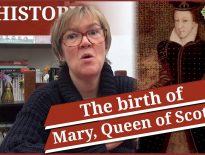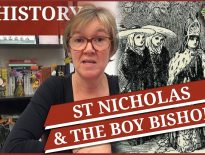Today, 7th December, is the traditional date given for the birth of Henry Stuart (Stewart), Duke of Albany and Lord Darnley, in 1545.
Lord Darnley was the son of Margaret Douglas and grandson of Margaret Tudor, Queen of Scotland, and her second husband, Archibald Douglas, 6th Earl of Angus, but he is more known as the second husband of Mary, Queen of Scots.
Find out about Lord Darnley's rather colourful life, his unhappy marriage, his role in a murder, AND his own sticky end, in today's talk.
You can find out about Darnley's murder in this video
Also on this day in history:
- 1549 – Hanging of Robert Kett, leader of Kett's Rebellion in Norfolk. Kett was hanged from the walls of Norwich Castle after being found guilty of treason by a commission of oyer and terminer. He had been captured the day after the Battle of Dussindale, which ended the rebellion. His brother, William, was also hanged on the same day, but at Wymondham Abbey.
- 1573 – Death of John Thorne, Master of the Choristers and Organist of York Minster, composer and poet, in York. He was buried in York Minster.
- 1613 – Death of Thomas Hesketh, botanist and physician, at Clitheroe Castle. John Gerard used Hesketh as a source for his “Herball” and was known for supplying gardens and nurseries with seeds and plants, including wild flowers.
- 1626 – Death of Sir John Davies, lawyer, politician, Attorney-General for Ireland and poet. Davies was found dead on the morning of the 8th December, the day that he was going to be installed as Chief Justice of the King's Bench. He was buried at St Martin-in-the-Fields, Westminster, and John Donne preached at his funeral service. Davies sat in the House of Commons in the reigns of Elizabeth I and James I, and was a favourite of Elizabeth I. His work included the 1599 “Hymns of Astraea”, which he addressed to the queen, and “Orchestra” (1595).
Transcript:
The 7th December 1545 is the traditional date given for the birth of Henry Stuart (Stewart), Duke of Albany and Lord Darnley.
Darnley was the son of Matthew Stewart, 13th or 4th Earl of Lennox, and Lady Margaret Douglas. His maternal grandparents were Margaret Tudor, Queen of Scotland and daughter of King Henry VII, and her second husband Archibald Douglas, 6th Earl of Angus. His paternal grandparents were John Stewart, 12th or 3rd Earl of Lennox, and his wife, Elizabeth Stewart.
Darnley was born at Temple Newsam, Yorkshire, allegedly not long after the death of his older brother, also called Henry. Darnley is known for being the second husband of Mary, Queen of Scots and for being murdered on 10th February1567.
Here is some trivia about Darnley:
• He had claims to both the Scottish and English thrones, being descended from James II of Scotland and Henry VII of England.
• His biographer Elaine Finnie Greig describes Darnley as “an elegant dancer, and accomplished in singing and in playing the lute; physically he was strong and athletic, a good horseman with a knowledge of weapons and a passion for hunting and hawking” but only “an average student for the time”.
• His father was declared a traitor after he had taken part in the War of the Rough Wooing between England and Scotland.
• Darnley travelled to Scotland in February 1565 and met Mary, Queen of Scots, who, according to the Scottish ambassador “took well with him, and said that he was the lustiest and best proportioned long man that she had seen”. She was very taken with him and he was constantly in her presence from that point on.
• Darnley suffered with an attack of measles in April 1565.
• He was created Knight of Tarbolton, Lord Ardmannoch, and Earl of Ross in May 1565, and swore his allegiance to Mary, Queen of Scots.
• On the 22nd July 1565, he was made Duke of Albany in anticipation of his marriage to Mary.
• Darnley married Mary, Queen of Scots on 29th July 1565, and was proclaimed "King Henry" the following day, although Mary refused to grant him the crown matrimonial.
• He wasn’t popular in Scotland, being described as having “an insolent, imperious temper”.
• Mary soon realised her mistake in marrying Darnley, and the couple were estranged by Christmas 1565, even though Mary was pregnant by then.
• In March 1566, Mary's private secretary David Rizzio was stabbed to death by a gang of assassins led by Darnley.
• His son, the future James VI and I, was born on 19th June 1566. Darnley refused to attend his baptism on 17th December 1566, which was performed with full Roman Catholic rites.
• Darnley was taken ill with what was said to be smallpox, but is now thought to have been syphilis, in January 1567.
• While he was convalescing at Kirk o’Field, just a few hundred yards from Holyrood House where his wife, Mary Queen of Scots, and baby son, the future James VI/I, were staying, he was murdered on 10th February 1567. There was an explosion, but Darnley had already been killed. He was probably smothered.
• Although Mary observed forty days of mourning for her husband, there were rumours that she was insincere and that she was involved in his murder. It was not long before the Earl of Bothwell's name (James Hepburn, 4th Earl of Bothwell) was linked to Darnley's murder.
• Mary married Bothwell in May 1567 after he had allegedly held her hostage and raped her.
• Lord Darnley's murder and Mary's links with Bothwell were factors in her eventual trial in 1586.
• After his murder, Lord Darnley was laid to rest in the royal vault at Holyrood Abbey.



Leave a Reply